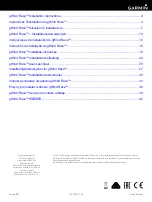
100
AW T4 20 |
U N I V ER S A L 4 - W I R E , D UA L- I N P U T T R A N SM I T T ER | O I/AW T4 2 0 - EN R E V. B
…Appendix B 2-electrode conductivity calculations
…Automatic temperature compensation
Calculation of temperature coefficient
The temperature coefficient of a solution can be obtained
experimentally by taking non-temperature compensated
conductivity measurements at two temperatures and applying
the following expression:
G – G
G (t – 25) – G (t – 25)
t2
t1
t1
t2
∞ =
2
1
Where:
G
t2
=
conductivity measurement at a
temperature of t
2
°C
G
t1
=
conductivity measurement at a
temperature of t
1
°C
One of these measurements could be made at the ambient
temperature and the other obtained by heating the sample.
Temperature coefficient (%/°C) = ∝ x 100.
For ultra pure water applications the temperature
compensation equation becomes,
G – G
[G (t – 25) – G (t – 25)]
imp1
imp2
imp2
imp1
∞ =
1
2
Where:
G
imp1
=
G
t1
– G
upw1
G
imp2
=
G
t2
– G
upw2
Relationship between conductivity and total
dissolved solids (TDS) measurement
The TDS factor (i.e. the relationship between conductivity
[µS cm
-1
] and TDS in ppm) is totally dependent on the
properties of the solution being measured.
In simple solutions where only one electrolyte is present, the
conductivity/TDS ratio can be ascertained easily, e.g., 0.5 in the
case of sodium chloride. However, in complex solutions where
more than one electrolyte is present, the ratio is not calculated
easily and can be reliably determined only by laboratory testing,
e.g., precipitation and weighing. The ratio in these cases varies
between approximately 0.4 and 0.8, depending on the chemical
constituents, (e.g., the ratio for sea water is about 0.6) and is
constant only when the chemical ratios remain constant
throughout a particular process.
In cases where the TDS factor cannot be determined easily,
refer to the supplier of the particular chemical treatment being
used.











































